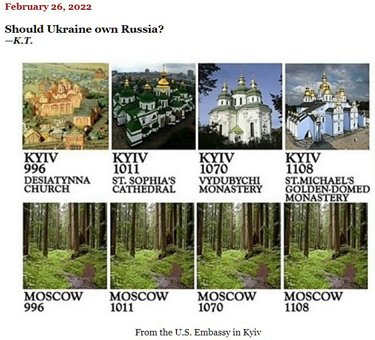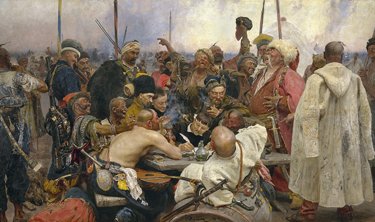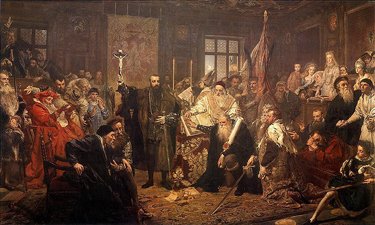
The Eastern Slavic state started with Kiev, and the Eastern Slavs became part of Western Civilization when Saint Vladimir the ruler of Kievian Rus’ converted to Christianity.
Moscow was founded as just another city/state of Kievian Rus’.
The city-states of White and Black Russia were referred to as Rus’ [Roosh]. Moscow was called Rossiya.
The history of the Eastern Slavs diverged in the 1240s as the result of the Great Mongol Invasion. Kievian Rus’ was swept away. Kiev resisted and was destroyed. Moscow surrendered to the Horde, and the dukes of Moscow (the ancestors of later self-styled “Caesars,” the first of whom bestowed that title on himself following his marriage in 1472 to a princess of defunct Byzantium, fallen to the Turks in 1453) served as tax collectors to the Horde and knocked their foreheads on the ground in submission to the Khan at Sarai.
White and Black Russia (today’s Belarus) sought the protection of the mLithuanian princes and joined Lithuania and consequently were never taken by the Mongols. Ukraine was liberated via a Reconquista by the Lithuanians piece by piece with Grand Duke Vytautas finishing standing by the Black Sea in 1399.
The Cossacks, referred to in Ace’s history, began as escaped Lithuanian serfs who fled to the uninhabited steppe borderlands, intermarried with the Tartars, and lived as outlaw brigands, preying on the Turks.

Ilya Repin, Запорожцы пишут письмо турецкому султану, [Cossacks write a letter to the Turkish sultan], 1880-1891, State Russian Museum, Saint Petersburg.
In 1569, the Lithuanian dynasty ruling the combined state of Poland-Lithuania (formed in 1386, when the Lithuanian Grand Duke married the Polish Queen, converted to Christianity from Paganism, and became King of Poland, was doomed to expire because Sigismund Augustus refused to remarry when Barbara Radziwill, the love of his life died suddenly. “He left no heir but Liberty,” was the saying.

Jósef Simmler, Śmierć Barbary Radziwiłłówny [Death of Barbara Radziwill].
1860. National Musem, Warsaw.
Via the Union of Lublin, ties between Poland-Lithuania were strengthened, two parliaments were merged into one, and “The Union of Both Nations” became a Republic with an elective monarchy. In the course of the manueverings toward Union, Sigismund Augustus twisted the arms of reluctant Lithuanian magnates by transferring Ukraine from Lithuanian Administration to Poland.

Jan Matejko, Unia Lubelska [The Union of Lublin]. 1869. Muzeum Narodowe w Warszawie. Depozyt w Muzeum Okregowym w Lublinie.
This transfer of authority was not terribly successful. A great Cossack Rebellion, 1648-1657, was a bloodbath which led to the acquisition of Eastern Ukraine by Muscovy in 1654, and which marked the beginning of “the gathering of the Russian lands” by the despots of Moscow.
The rest of Ukraine was acquired by Moscow via the three Partitions of Poland in 1772, 1793, and 1795. The Russian Occupation of Poland, Lithuania, and Ukraine was resisted 1793-1795 under Kosciuszko, 1795-1815 in the Napoleonic Wars, 1831-1832 in the November Insurrection, 1863-1864 in the January Insurrection, and so on.








